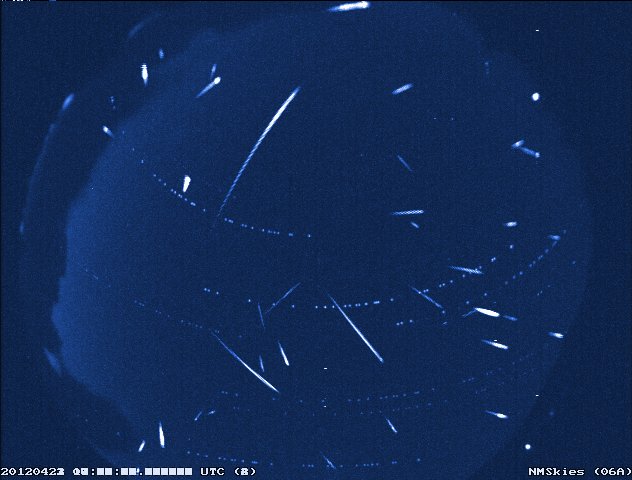Lyrid meteor shower: All you need to know
Bruce McClure and Deborah Byrd in ASTRONOMY ESSENTIALS | April 20, 2020
Yay! The Lyrids are here. We expect some meteors to be flying Sunday, Monday and Tuesday beginning late at night. In 2020, the likely peak is Wednesday morning, April 22. A new moon means excellent viewing conditions.

Composite image of Lyrid and not-Lyrid meteors over New Mexico from April, 2012. Image via NASA/ MSFC/ Danielle Moser. |
No matter where you are on Earth, the best time to watch is between midnight and dawn. You’ll want to watch in a dark country sky. Keep reading to find some tips for watching the 2020 Lyrids.
Tip #1: Learn about this shower’s radiant point. If you trace the paths of all the Lyrid meteors backward, they seem to radiate from the constellation Lyra the Harp, near the brilliant star Vega. This is only a chance alignment, for these meteors burn up in the atmosphere about 60 miles (100 km) up. Meanwhile, Vega lies trillions of times farther away at 25 light-years.
Tip #2: Observe from the country, away from city lights if you can.
Tip #3: Don’t expect too much.
Here are some other cool facts about the Lyrids.
The Lyrids have been known to have outbursts. For example, in 1982, American observers saw an outburst of nearly 100 Lyrid meteors per hour. Japanese observers saw around 100 meteors per hour in 1945, and Greek observers saw that number in 1922. No Lyrid outburst is predicted for 2020, but you never know.
About a quarter of Lyrid meteors leave persistent trains. A meteor train is an ionized gas trail that glows for a few seconds after the meteor has passed.
The Lyrid meteor shower has the distinction of being among the oldest of known meteor showers. Records of this shower go back for some 2,700 years. The ancient Chinese are said to have observed the Lyrid meteors falling like rain in the year 687 B.C. That time period in ancient China, by the way, corresponds with what is called the Spring and Autumn Period (about 771 to 476 B.C.), which tradition associates with the Chinese teacher and philosopher Confucius, one of the first to espouse the principle:
Do not do to others what you do not want done to yourself.
I wonder if Confucius saw any Lyrid meteors … it’s possible!
Comet Thatcher (C/1861 G1) is the source of the Lyrid meteors. Every year, in late April, our planet Earth crosses the orbital path of this comet. We have no photos of it because its orbit around the sun is roughly 415 years. Comet Thatcher last visited the inner solar system in 1861, before the photographic process became widespread. This comet isn’t expected to return until the year 2276.
Bits and pieces shed by this comet litter its orbit and bombard the Earth’s upper atmosphere at 110,000 miles per hour (177,000 km/h). The vaporizing debris streaks the nighttime with medium-fast Lyrid meteors.
It’s when Earth passes through an unusually thick clump of comet rubble that an elevated number of meteors can be seen.













 Reply With Quote
Reply With Quote